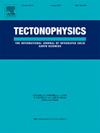Lithological control of the active Mejillones fault from Triassic to Quaternary, northern Chile
Abstract
Understanding the lithological control of crustal faults near cities is important for assessing the seismic hazard and characterising complex fault systems. We studied the Mejillones Fault (MF), located near one of the strategic ports in northern Chile. The MF is an active geological fault that extends 40 km in the N-S direction and is part of an extensive complex system of structures known as the Atacama Fault System (AFS). We built an S-wave tomography model using seismic ambient noise data that was recorded continuously in a dense network of stations from 2013 to 2015. The tomographic maps exhibited velocity anomalies that correlate with surface geology. We found lower velocities in the western part of the MF than in the eastern zone, with a shear wave velocity (Vs) of about 2.4 km/s, associated to fractured metamorphic rocks (Triassic) and marine sediments (Neogene-Quaternary). Higher velocities (Vs > 3.0 km/s) in the eastern part of the fault are related to igneous rocks from the Upper Jurassic. The difference in velocities between the western and eastern zones of the MF remained persistent in depth. The potential depth of the MF could be >5 km and delimits the boundary between 2 different geological zones. Intermediate Vs (∼2.8 km/s) at −23.25°, observed up to 4 km depth, can be associated with andesitic rocks deposited in an intra-arc basin (Upper Triassic) and accommodated by the MF over the last ∼200 Myr, evidencing the activity of this fault from Triassic to Quaternary.

 求助内容:
求助内容: 应助结果提醒方式:
应助结果提醒方式:


